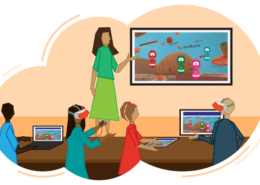In recent years, virtual reality (VR) has emerged as a transformative tool in education, offering immersive experiences that engage students in ways traditional methods cannot. From exploring historical sites to conducting complex scientific experiments, VR provides learners with opportunities to interact with content in a highly immersive and experiential manner. This article explores the efficacy of VR in education and its potential impact on learning outcomes.
Virtual reality refers to a simulated environment that can be similar to or completely different from the real world. It typically involves the use of headsets or goggles to immerse users in a computer-generated environment. In education, VR applications can range from virtual field trips to interactive simulations and educational games.
Efficacy of Virtual Reality in Education
1. Enhanced Engagement and Immersion
One of the primary advantages of VR in education is its ability to enhance engagement and immersion. By transporting students to virtual environments, VR captivates their attention and encourages active participation. Research has shown that immersive experiences lead to higher levels of engagement and retention compared to traditional methods.
2. Experiential Learning
VR facilitates experiential learning by allowing students to interact with content in a hands-on manner. For example, students studying anatomy can explore virtual human bodies in three dimensions, manipulating organs and observing physiological processes in real-time. This experiential approach enhances understanding and retention of complex concepts.
3. Accessibility and Inclusivity
Virtual reality can also improve accessibility and inclusivity in education. Students with disabilities or limited mobility can participate in virtual experiences that would otherwise be inaccessible to them. Additionally, VR enables personalized learning experiences, allowing students to progress at their own pace and catering to individual learning styles.
4. Cost-Effectiveness
While the initial investment in VR technology may be significant, it can ultimately lead to cost savings in the long run. Virtual field trips, for example, eliminate the need for expensive travel arrangements and logistical challenges associated with traditional excursions. Furthermore, VR simulations can reduce the consumption of physical resources required for hands-on experiments.
Potential Impact on Learning Outcomes
1. Improved Retention and Understanding
Studies have shown that VR can improve retention and understanding of educational material. By providing memorable and immersive experiences, VR stimulates multiple senses and reinforces learning through spatial awareness and sensory feedback. This enhanced retention translates into better academic performance and long-term knowledge retention.
2. Real-World Application
Virtual reality allows students to apply theoretical knowledge to real-world scenarios, preparing them for future careers and practical challenges. For instance, engineering students can simulate building projects, while medical students can practice surgical procedures in a risk-free environment. These hands-on experiences bridge the gap between theory and practice, fostering critical thinking and problem-solving skills.
3. Motivation and Engagement
VR motivates students by making learning more enjoyable and interactive. The novelty of virtual experiences captures students’ interest and encourages active participation. Moreover, VR enables educators to create customized learning experiences tailored to students’ interests and abilities, further enhancing motivation and engagement.
4. Equity in Education
Virtual reality has the potential to promote equity in education by providing all students, regardless of background or geographical location, with access to high-quality learning experiences. By breaking down barriers to education, VR can narrow the achievement gap and ensure equal opportunities for all learners.
Challenges and Considerations
While virtual reality offers numerous benefits in education, it also presents challenges and considerations that educators must address.
- Cost and Accessibility: VR technology can be costly, and not all schools have the resources to implement it effectively. Additionally, ensuring equitable access to VR experiences requires addressing issues of affordability and technological infrastructure.
- Content Quality and Curriculum Integration: Effective use of VR in education depends on the quality of content and its alignment with curriculum objectives. Educators must carefully select or develop VR applications that enhance learning outcomes and supplement traditional teaching methods.
- Ethical and Safety Concerns: As with any technology, VR raises ethical and safety concerns, particularly regarding data privacy, content appropriateness, and potential adverse effects on users, such as motion sickness or disorientation.
Conclusion:
Virtual reality holds tremendous promise as a tool for enhancing education and improving learning outcomes. By providing immersive, experiential, and personalized learning experiences, VR engages students in ways that traditional methods cannot. However, realizing the full potential of VR in education requires addressing challenges related to cost, accessibility, content quality, and ethical considerations. With careful planning and integration into curriculum design, VR has the potential to revolutionize education and prepare students for success in the 21st century.

